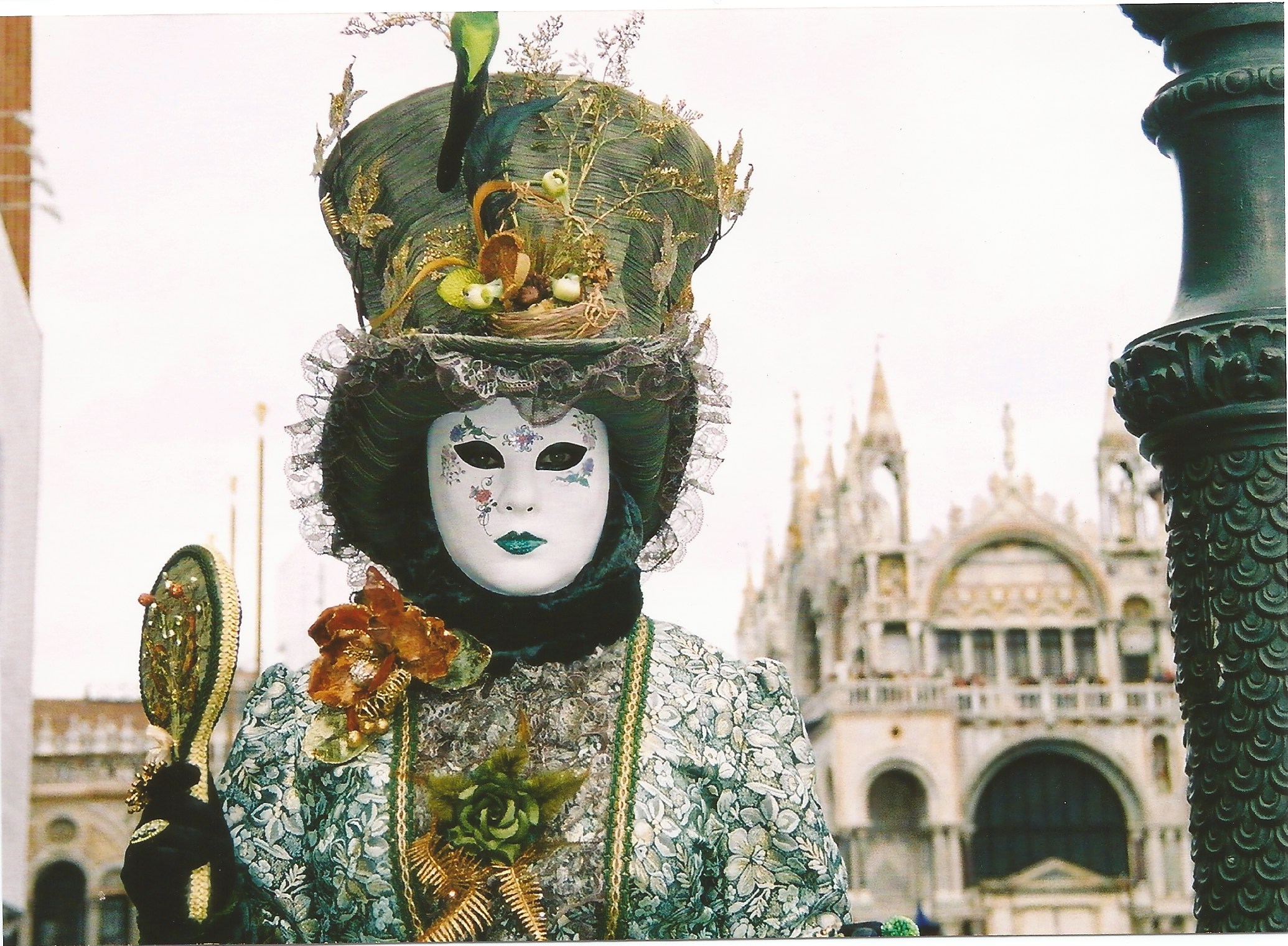I remember climbing on the backrest of an old settee in order to look out of our third floor window at Piazza dell’Unità to see the other children already on their way to the Sala Cinematografica Cola Di Rienzo (today, a Bingo palace) for the costume parade. It was not the first time I too would be sashaying on the stage of the cinema hall for at stab at the “best costume prize”. I had done it before I am told, but my memory, able to reach only so far, takes me to this one particular year when I was to dress like a “zingarella”, a gypsy lady with a kerchief wrapped around my heavy curls, a long swinging taffeta skirt and a little bolero of colourful stitched-together ends of various fabrics and a trim of many jangling silver coloured coins . My mother had made me a little pouch that I carried tied around my waist and which was full of coriandoli, the paper confetti that the children dutifully would sprinkle on each other as they met along the streets of Rome at Carnevale. The sidewalks already carpeted with a million coriandoli gave the city the festive look and feel of Mardi Gras.
Once in the theatre, I did not need any encouragement to leave my seat and join the other six year olds as they paraded up the side steps and across the stage before an audience of cooing and fawning parents. I did not win the prize that year, nor any other for that matter, but perhaps, this was the defining moment when I became the drama queen that I am today!
Carnevale was not just about the costumes when I was a child; it was also about the heavenly sweet confections that were invariably prepared at this time each year. Even after we arrived in Canada the custom to bake, fry and douse with syrups, icing sugar and coloured sprinkles remained intact. It allowed us, as my mother would remind us, to remember where we came from and our rich traditions. Only here, in our new home, the traditions were many and varied, from all parts of Italy: Vitina, my aunt, made the wonderful sugar glazed taralli from Puglia; la signora Maria, our neighbor, made the pignolata so popular in Calabria. My mother made “frappe”. She called these dainty, light as air pastries “frappe” because that’s what they were called in Rome. Back home in Basilicata, where she was from, they were known as “crespeddozze”; in Tuscany “chiacchere” and in the north, “crostoli”.

As I was growing up, Carnevale came to be associated with a celebration of sweets and cakes and delectable delights. And I watched as my mother kneaded, fried and churned out the frappe, year after year until finally, the day arrived that we were all on diets or my mom just did not have the will, nor the energy any longer to bake for Carnevale.
A yearning borne out of my naturally sweet tooth, or perhaps for the past, finally gave me the incentive some years ago, to try my hand at making my mom’s famous (to us) frappe. By this time, she declared, she had forgotten the recipe! “maybe two…maybe three eggs” “not quite two cups….I think”. It was no use. No amount of cajoling, of begging, or of trying to stimulate her memory, worked. She simply couldn’t or wouldn’t remember the complete recipe.
I tried desperately to find something similar to my mom’s own recipe on the Internet; a call to my aunt and sundry old friends bore no results. This was no longer about retrieving an old recipe; this was about finding and safeguarding a moment in my past.
I began to understand my almost fanatical need to find this recipe again: it represented a time, when safe within the bosom of family, you were cared for, cosseted, and delighted with treats that stood for unconditional love. And now, I was struggling to hang on to my mother and to her motherly love as it slowly slipped away.
A few weeks ago, as it often happens to me lately, I was remembering my mom and reminiscing of old times. I knew that this was just a trick I taught myself in order to get out of facing the emotional and sometimes insufferable job of organizing my basement. Shaking myself from my self-imposed reverie, I opened an old tin box, one of many oddities I am constantly finding in the most remote corners of our basement museum, and found to my surprise that it was a recipe box. My mother, who had never written down anything except girlfriends’ phone numbers, had in fact commended to posterity her recipes.
But, don’t get ahead of me: my mother’s idea of a recipe was a list of ingredients, and nothing else; a cut-out picture of a roast, a friend’s name in order to call her to ask how much ricotta she should add to the manicotti.
I laughed softly to myself and continued to leaf through the papers in the box. A particular oil stained, yellowed paper caught my eye. Unfolding it, I read “Per fare bene le Frappe…” (how to make good Frappe), and there, written in her hand in the most precise and detailed manner, was the recipe.
“A Carnevale ogni scherzo vale”, and if indeed at Carnival any trick goes, this year, my mom has played the best trick on me.
Miss you, mom.



“Per Fare Bene le Frappe”
3 eggs plus 1 yolk2 cups flour, sifted1 tablespoon of icing sugar1 tablespoon of oil (not necessarily olive)1 shot glass of rum, whiskey or grappaicing sugar to dust*Beat the eggs with icing sugar in electric mixer until light in colour.*Add, while beating, the liquor*On a wooden board or stone counter make a well with the flour andgradually add the eggs in the centre mixing well all ingredients.*knead by hand until dough is soft and smooth and shiny. Add more floursparingly if the dough is too sticky.* Wrap in cellophane and allow dough to rest for at least one hour.To form the Frappe, cut off a small piece of dough at a time and run through a pasta machine until it is as thin as cardstock. Cut into strips, 5-6” long and 2-3” wide. Pinch in the middle of the strip to form a bow and place on floured surface until ready to fry. Heat a good 2” of Vegetable oil in a large frying pan and drop bows into sizzling oil. Allow the bows to turn light golden ( a minute or so) and flip to other side. Drain on paper towels.Dust the frappe with icing sugar and store in closed container.
Buon Carnevale!!
0



